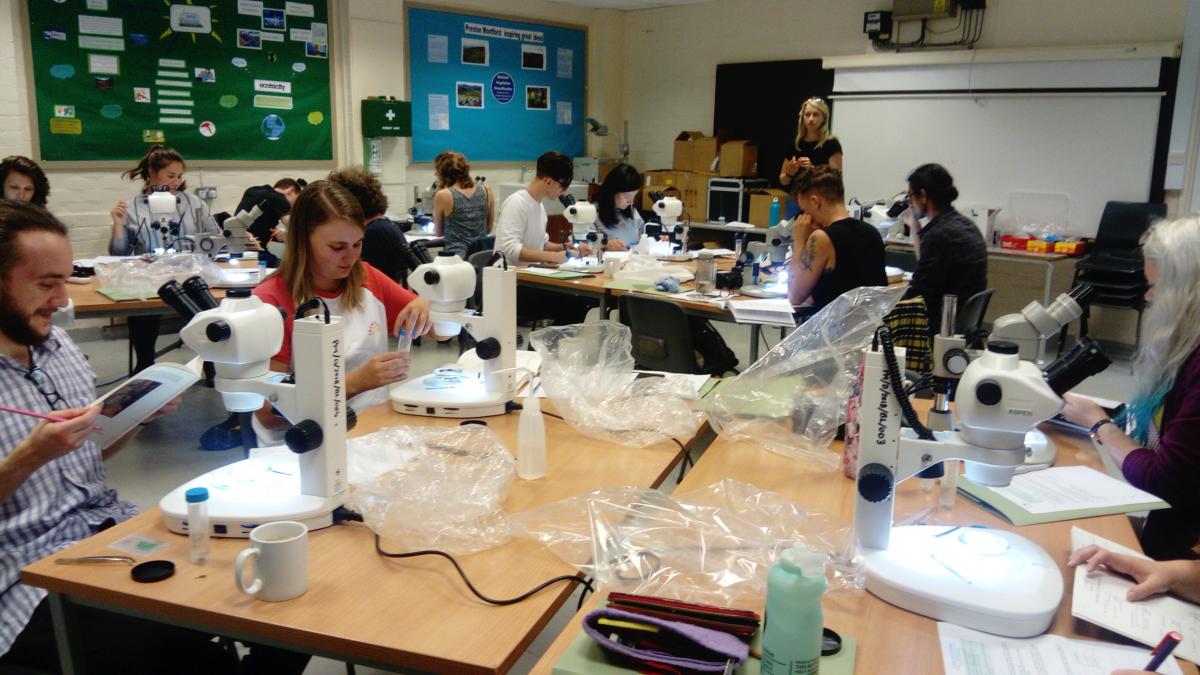Tomorrow's Invertebrate Recorder: Sarah Maguire

I work for the Jersey Biodiversity Centre, a local wildlife record centre, as the Education and Outreach Officer. The main part of my role is to create activities for all ages to experience native wildlife and collect records for the centre. We have a pool of volunteers who submit wildlife records to the centre and help at our events, another part of my role is to support them. I won a place on the "Tomorrow's Invertebrate Recorders" course - a week long residential programme for young people (aged 18-25) run by the FSC BioLinks project and A Focus On Nature providing an introduction to surveying invertebrates. I found the course really useful and am incorporating a lot of what I learnt into my work. Here's how the course helped me:
I wanted to learn more about invertebrates so when I returned to the island I could share my knowledge to help inspire more recorders
I applied to the Tomorrow's Invertebrate Recorders course with very little knowledge of invertebrate identification, only what I have gained by running bug hunts with enthusiastic children. The week long course was packed with surveying opportunities which I thoroughly enjoyed - I also enjoyed being able to focus on the invertebrates and not having to manage a pack of 30 children running wild with sweep nets!
Improving my identification and recording skills
The course programme was a mixture of recording and identification skills, both vital for working at a wildlife record centre. We spent time exploring the grounds at Preston Montford and Carding Mill Valley recording species and locations for entering on iRecord. Learning how to better use this website has helped my confidence when using the Jersey record centre’s website, which is built on the same system as iRecord. Using iRecord has also helped me in my role when using the app with volunteers and helping new recorders get set up and confident in recording.
During the course, we discussed why recording is important for conservation, what is vital when making a wildlife record and what information you need to collect when designing citizen science projects or government recording schemes. This knowledge gained is very useful to me in my role as we are involved in creating survey projects, supporting university student research and supporting other wildlife charities with their research and projects. Knowing when to include additional information to a recording scheme has allowed me to focus our projects on the both the recorder’s and project needs, to help put more records on the map.
%202%20.jpg)
Recording in Carding Mill Valley
We spent a day learning the basics of invertebrate identification and then were able to specialise. Out of the options, I decided to focus on spiders because of their excitement status when we run creepy crawly hunts at work and felt like this could be the order to get people excited about recording wildlife. Spiders in Jersey are an under recorded group yet we can see one everyday, whether it’s our homes, car mirrors, or in the garden. I wanted to learn more so when I returned to the island I could share my knowledge to help inspire more recorders.
I had wanted to learn about spiders for quite some time and was very excited to spend two days learning how to identify and record them with Nigel Cane-Honeysett, Shropshire's Arachnid Recorder, and Holly Dillon, from the BioLinks Project. Nigel’s enthusiasm for spiders is contagious! After learning about spider habitats, spider web identification and spider family identification features, we spent time in the field looking for some. Learning how to identify the family groups was key to me improving my spider field skills, as so many species require microscopes to get to species level. I think that starting with family ID, rather than jumping straight to species, and building on that knowledge gave me a better understanding for their anatomy and key features to look for in the field so I'm now much more confident in my field skills.
On the course, we also learnt how to create a SpiPot (a pot used for looking at spiders or other invertebrates without damaging them - you can learn how to make them here). This was great fun and this activity is something I will be doing with the groups of volunteers at work to help them make their own equipment for surveying. Finding out that you can use an electric toothbrush to coax out tube web spiders was also thrilling (the buzzing of the brush mimics a fly caught in the web!) and I was excited to take this idea back for our creepy crawly hunts with children. The survey methods covered in the course enforced that you do not need a vast array of expensive equipment to study and record invertebrates, you can make your own! For a record centre who relies on volunteers, I was pleased to discover this and it enforced that anyone could get involved with recording.

Spider ID using microscopes and keys
Our second day of spider ID was focused around species identification using microscopes. Learning the process of using a key for identification and keying out features was satisfying when you get to the end and have the correct species. We currently do not use our microscopes as much as we would like at work for species identification and, as the day proved to be relaxing and fun, it will be something I will do with the volunteers at work to help improve their confidence when identifying invertebrates.
Attending this course has given me new ideas of how to engage the public with wildlife
It was amazing and rewarding to meet new invertebrate enthusiasts, and on returning home I had heaps of energy and enthusiasm for surveying. Attending this course has given me new ideas of how to engage the public with wildlife. Since coming back to Jersey, I have set up a Spider recording group and shared what I learnt from this course recently at a Spider ID evening. In Halloween season we ran Spider Safaris for both children and adults and I’ve trailed a spider web workshop with a Year 6 class at a local school. I want to thank the course leaders for their patience and enthusiasm and I’m excited to share the spider love to help people record wildlife they see every day!
- Blog by Sarah Maguire
- Anonymous's blog
- Log in or register to post comments

2436.jpg?itok=kQo5uiNW)

